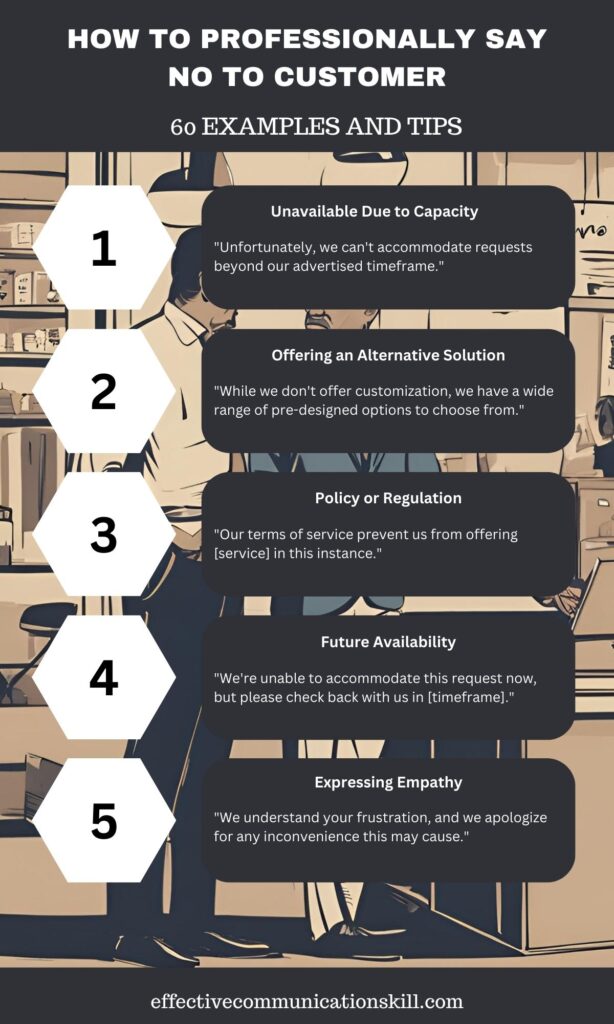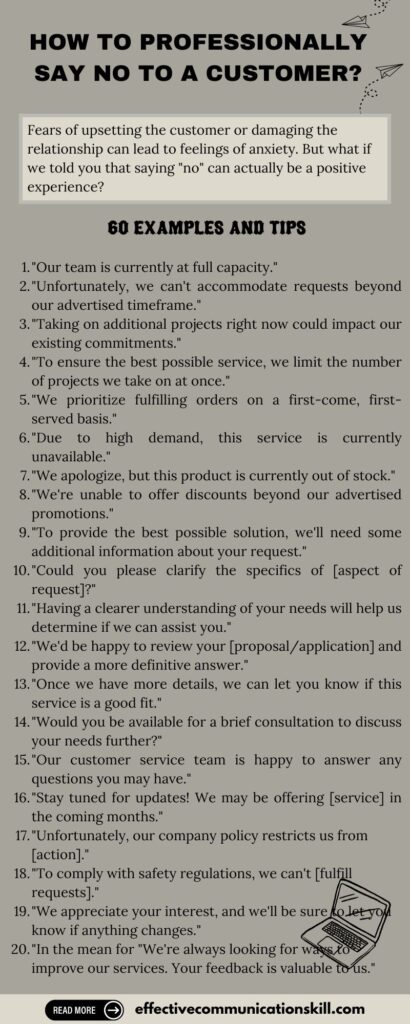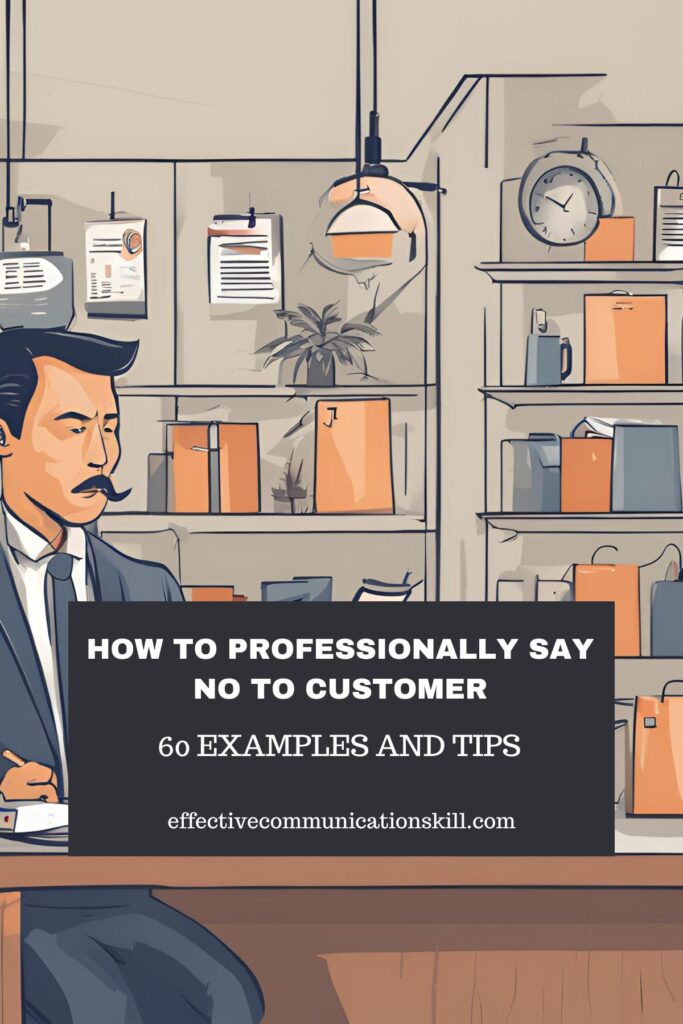How to Professionally Say No to a Customer
Did you know that a recent study by Bain & Company found that increasing customer retention by just 5% can boost your profits by up to 95%?
While exceptional customer service is a key driver of retention, there’s a scenario that can leave even the most service-oriented professional feeling conflicted: saying “no” to a customer request.
Fears of upsetting the customer or damaging the relationship can lead to feelings of anxiety. But what if we told you that saying “no” can actually be a positive experience? This guide will equip you with the tools to navigate these situations confidently.
How to Professionally Say No to a Task – How to Professionally Say No to a Task- We’ll explore effective communication strategies, explore helpful alternatives, and show you how to turn a potential negative into a positive customer experience.

How to Professionally Say No to a Customer
The following are a few Tips on formal and professional ways to say no to a customer:
- Acknowledge and Appreciate: Begin by thanking the customer for reaching out and acknowledging their request.
Example: “Thank you for contacting us about [service/product].”
- Deliver the “No” Clearly: State your decline in a direct but polite manner.
Example: “Unfortunately, we won’t be able to [fulfill request] at this time.”
- Explain Briefly (Optional): If comfortable, offer a brief explanation for your decline. Keep it concise and professional.
Example: “Our current production schedule is full, and we want to ensure timely delivery for existing orders.”
- Offer an Alternative (Optional): If applicable, suggest another solution or product that might be a better fit.
Example: “We don’t offer custom engraving, but we do have a wide variety of pre-designed options you might like.”
- Close with Courtesy: End your interaction with a polite closing and offer your help in the future.
Example: “Thank you for your understanding. Please don’t hesitate to reach out if you have any other questions.”
50+ Ways to Professionally Say No to a Customer
Here are various ways to professionally say no to a customer for different scenarios:
Unavailable Due to Capacity
- “Our team is currently at full capacity.”
- “Unfortunately, we can’t accommodate requests beyond our advertised timeframe.”
- “Taking on additional projects right now could impact our existing commitments.”
- “To ensure the best possible service, we limit the number of projects we take on at once.”
- “We prioritize fulfilling orders on a first-come, first-served basis.”
- “Due to high demand, this service is currently unavailable.”
- “We apologize, but this product is currently out of stock.”
- “We’re unable to offer discounts beyond our advertised promotions.”
Declining a Request Outside Expertise
- “While we appreciate your interest, this falls outside our area of expertise.”
- “We may not be the best fit for this particular request.”
- “To best serve your needs, we recommend contacting a specialist in [area].”
- “Our products are designed for [intended use], and may not be suitable for your application.”
- “We don’t currently offer repairs for this specific model.”
- “Unfortunately, we can’t provide technical support for third-party products.”
- “Our return policy excludes [reason for exclusion].”
- “We’re unable to process warranty claims beyond the one-year period.”
Offering an Alternative Solution
- “We can’t fulfill this request exactly, but we offer a similar product in [variation].”
- “While we don’t offer customization, we have a wide range of pre-designed options to choose from.”
- “We understand your need for [urgency], but expedited shipping comes with an additional fee.”
- “If you’re open to exploring alternatives, we recommend [suggestion].”
- “Perhaps our [different service] might be a better fit for your needs.”
- “We’d be happy to connect you with a company that specializes in [area].”
- “Would you be interested in joining our waitlist for [product]?”
- “We’ll keep you updated on future availability of this service.”
Needing More Information
- “To provide the best possible solution, we’ll need some additional information about your request.”
- “Could you please clarify the specifics of [aspect of request]?”
- “Having a clearer understanding of your needs will help us determine if we can assist you.”
- “We’d be happy to review your [proposal/application] and provide a more definitive answer.”
- “Once we have more details, we can let you know if this service is a good fit.”
- “Would you be available for a brief consultation to discuss your needs further?”
- “Our customer service team is happy to answer any questions you may have.”

Policy or Regulation
- “Unfortunately, our company policy restricts us from [action].”
- “To comply with safety regulations, we can’t [fulfill requests].”
- “We apologize, but our insurance policy doesn’t cover [situation].”
- “Our terms of service prevent us from offering [service] in this instance.”
- “We’re unable to process returns on [specified items].”
- “We can’t disclose customer information due to privacy regulations.”
- “We recommend consulting with a professional regarding [legal/financial matters].”
Future Availability
- “We don’t currently offer this service, but we’re considering it for the future.”
- “We’re unable to accommodate this request now, but please check back with us in [timeframe].”
- “Stay tuned for updates! We may be offering [service] in the coming months.”
- “Sign up for our newsletter to be notified about future availability of [product].”
- “Keep an eye on our social media for announcements about new product launches.”
- “We appreciate your interest, and we’ll be sure to let you know if anything changes.”
- “In the meantime, we recommend exploring these similar products we currently offer.”
Expressing Empathy
- “We understand your frustration, and we apologize for any inconvenience this may cause.”
- “We appreciate your patience as we work to meet the high demand for [product].”
- “We regret that we can’t fulfill your request exactly, but we’re committed to finding a solution.”
- “We value your business, and we want to ensure a positive experience for all our customers.”
- “While we can’t say yes this time, we hope you’ll consider us for future needs.”
- “We’re always looking for ways to improve our services. Your feedback is valuable to us.”
- “Thank you for your understanding. We wish you the best of luck in finding a solution.”
- “Is there anything else we can do to assist you today?”
Examples in Action: Putting Your “No” to Work
Let’s look at some real-life scenarios and see how you can use the tips above to craft effective responses:
Scenario 1: Tight Deadline
Customer: “We need this custom order by next week. Can you rush it?”
Your Response: “Thank you for your business! Unfortunately, due to our current production schedule, we wouldn’t be able to guarantee next-week delivery for a custom order. However, we can offer expedited shipping on a pre-made option that might meet your needs. Alternatively, we could place a rush order for your custom piece, but the estimated delivery would be [date]. Which option would you prefer?”
Scenario 2: Service Not Offered
Customer: “Can you repair my cracked phone screen?”
Your Response: “We appreciate you reaching out! Unfortunately, we don’t offer phone screen repairs at this time. However, we can recommend some reputable repair shops in the area that might be able to assist you. Would you like me to send you some contact information?”
Scenario 3: Unavailability Due to Policy
Customer: “I’d like a full refund for this product, even though it’s past the return window.”
Your Response: “We understand your situation. Unfortunately, our return policy allows for full refunds only within [timeframe] of purchase. We do offer store credit for returns outside this window. Alternatively, the manufacturer may have a warranty policy that covers this issue. Would you like me to provide you with the manufacturer’s contact information?”
By following these strategies, you can navigate these situations confidently and professionally, while still prioritizing customer satisfaction.
Scenario 4: Limited Budget
Client: “We love your design portfolio, but your rates are a bit outside our budget for this project.”
Your Response: “Thank you for your interest in our work! We understand that budget is a key consideration. While our standard rates are [rate], we might be able to offer a scaled-down package that focuses on the most critical aspects of your project to meet your budget. Alternatively, we can connect you with some talented designers who might offer services at a lower price point. Would you be interested in discussing these options further?” (Acknowledge limitations and offer alternative solutions)
Scenario 5: Unrealistic Expectations
Colleague: “Hey [Your Name], I just started writing this proposal. Can you take a look and finish it by the end of the day?”
Your Response: “Absolutely, I’m happy to help! However, given the complexity of this proposal, a thorough review and completion by the end of the day might be challenging. To ensure a high-quality document, would tomorrow morning work as a deadline? In the meantime, I can offer some quick feedback on the sections you’ve already written.” (Explain limitations and offer alternative solutions)

Conclusion
Saying no to a customer doesn’t have to be a negative experience. By approaching these situations with professionalism, empathy, and a solution-oriented mindset, you can effectively manage expectations, protect your resources, and even strengthen your customer relationships.
Remember, the key lies in clear communication, offering alternatives when possible, and maintaining a positive and courteous tone. So next time you need to decline a request, take a deep breath, and put these tips into action. You might be surprised at how a well-crafted “no” can pave the way for a positive outcome.
